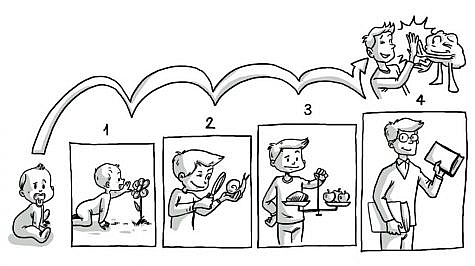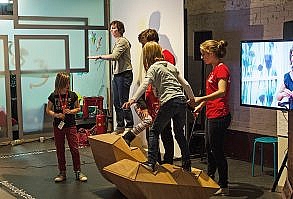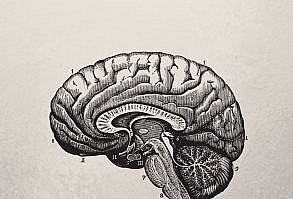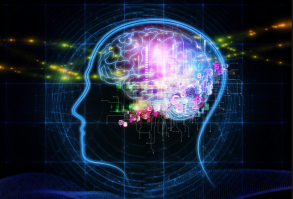According to Jean Piaget’s theory of cognitive development (1936-50), children’s brain evolves through time. A kid’s cognitive growth entails more than simply collecting information; the youngster must also create or build a mental picture of the world. Children go through a variety of phases as their cognitive development is influenced by their intrinsic abilities and surrounding experiences. This biologic maturation is categorized as follows:
- Sensorimotor stage (0-2): Object permanence
- Preoperational stage (2-7): Symbolic thought
- Concrete operational stage (7-11): Logical thought
- Formal operational stage (12+): Scientific reasoning
In the 1920s, Piaget worked at the Binet Institute, in which his mission was to provide French translations of questions from English intelligence tests. He was fascinated by the explanations kids made for giving incorrect responses to issues that needed logical reasoning. Piaget also employed natural observation of his three kids, as well as controlled observation, to study youngsters from birth through adolescence. He created journal entries out of them, chronicling their progress.
He argued that these wrong responses demonstrated significant disparities between adult and kid thinking.
Piaget, thus, developed a new set of assumptions regarding children’s intelligence:
- Children’s cognition is qualitatively different from that of adults, rather than quantitatively. This implies that youngsters reasoning is different from adults and have a unique perspective on the world.
- Children are constantly developing their understanding of the world. They are not passive individuals awaiting information to be transmitted to them.
- The most effective technique to comprehend children’s thinking was to view events through their eyes.
Piaget presumes that every newborn has an inherently basic cognitive structure in which there are schemas like mental models of the real world items when a person first encounters them. Somebody, for example, might have a schema about playing a game. The schema has been stored as a form of behavioral pattern as a representation that involves obeying the rules in the game.
The cognitive structure is going through a process called adaptation while growing. The adaptation consists of assimilation, accommodation, and equilibration. Assimilation is defined as integrating new information into available schemas in the brain. Accommodation, on the other hand, could be described as revisiting the available schemas to integrate new information when the existing schemas do not address it. Equilibration also refers to the effort to seek order rather than conflicts as part of vagueness.
Implications for Educational Practices
Although Piaget did not provide a direct relationship with the educational practices, researchers who delved into cognitive development have sought to understand how this theory could be applied to an educational context. Piaget’s ideas affected policymakers while making nationwide educational and curriculum planning such as the United Kingdom in 1966. Additionally, Discovery learning emerged as an idea that kids might learn best during exploration, which has been a transformative effect in education. Furthermore, the theory proposes that learning should be student-centered along with tasks that promote active learning.
Criticisms
- Age range for each stage is not scientifically proven.
- Piaget underestimated the role of social learning and culture while underlining the universal stages of cognitive development.
- Piaget made subjective observations since there was no other researcher to increase the realiability.
- The notion of schema include conflicts with Bruner (1966) and Vygotsky (1978) and does not comply with Behaviorsm as it promotes an internal process rather than external one.
- Piaget assumes that language precedes thinking, which refute the idea of Vygotsky as he stated language and thinking are hand in hand due to its role as medium for social interaction.
Further resources
Sproutsschools: Piaget Cognitive Development
Applypsychology: Cognitive Development
Wikipedia: Piaget
References
Piaget, J. (1932). The moral judgment of the child. London: Routledge & Kegan Paul.
Piaget, J. (1936). Origins of intelligence in the child. London: Routledge & Kegan Paul.
Piaget, J. (1945). Play, dreams and imitation in childhood. London: Heinemann.
Piaget, J. (1957). Construction of reality in the child. London: Routledge & Kegan Paul.
Piaget, J., & Cook, M. T. (1952). The origins of intelligence in children. New York, NY: International University Press.
Vygotsky, L. S. (1978). Mind in society: The development of higher psychological processes. Cambridge, MA: Harvard University Press.
Please feel free to contact me if you need any further information.




